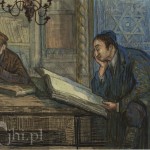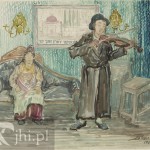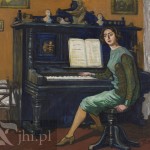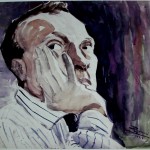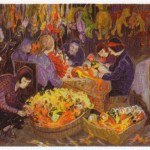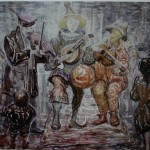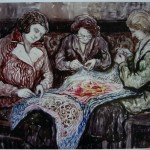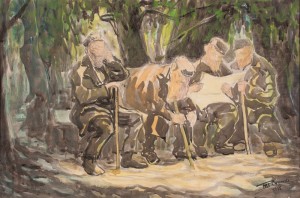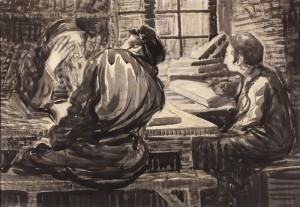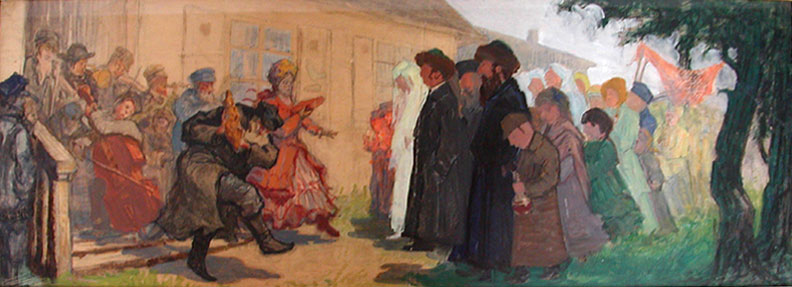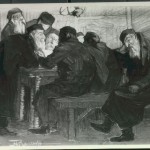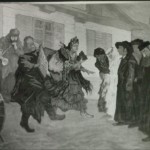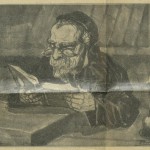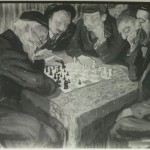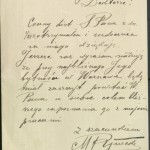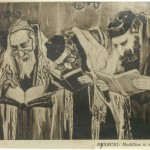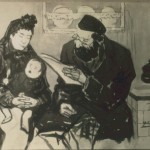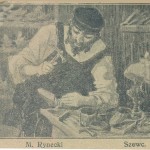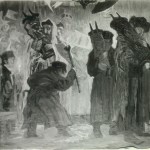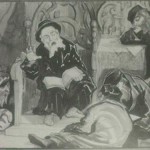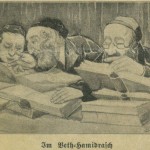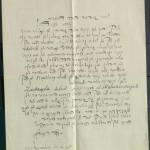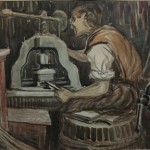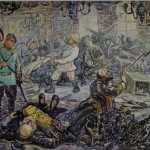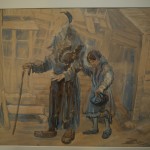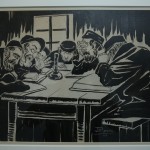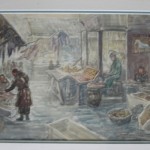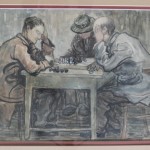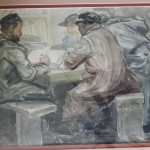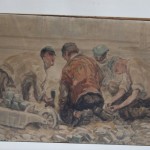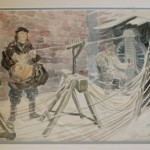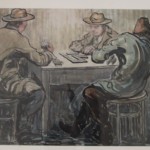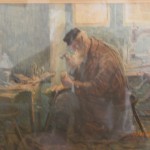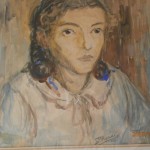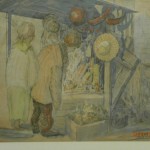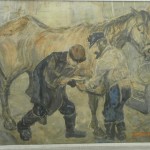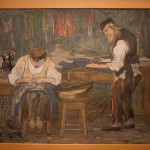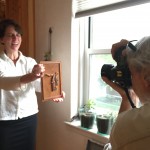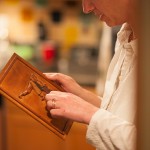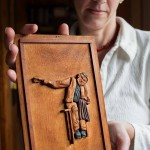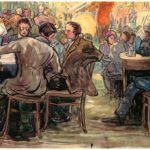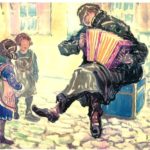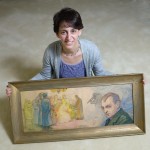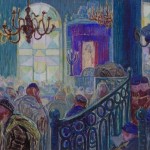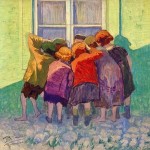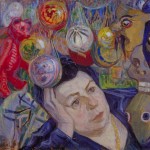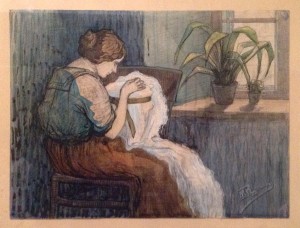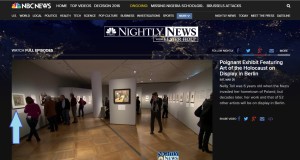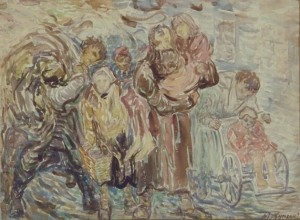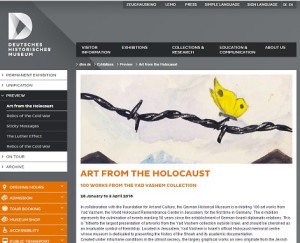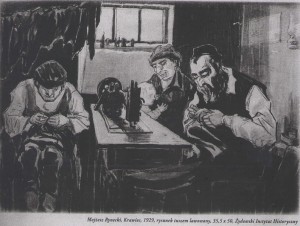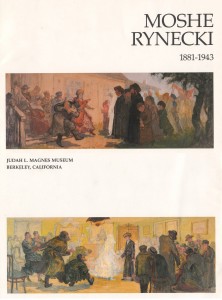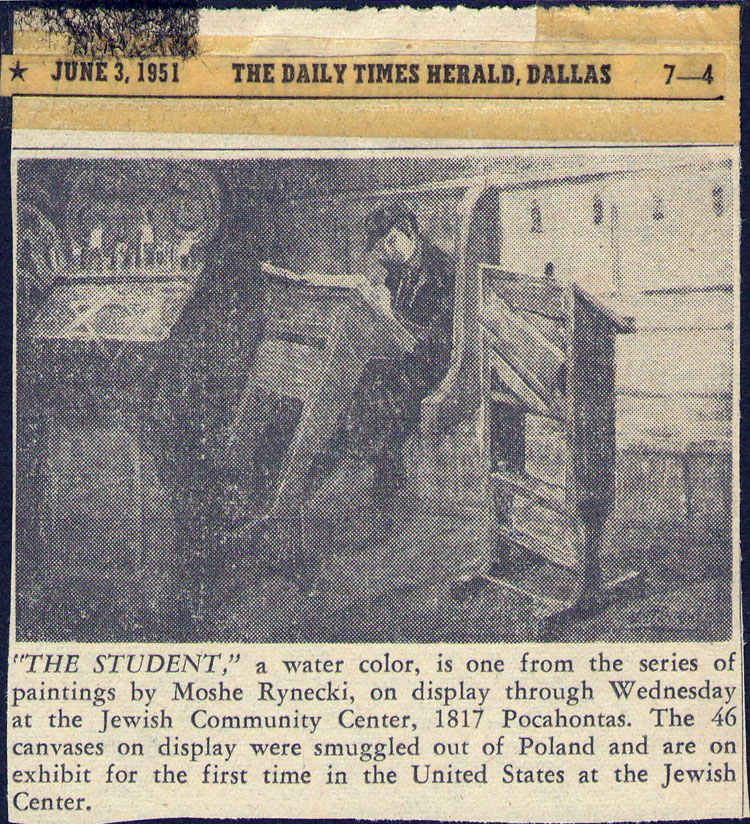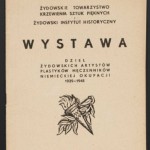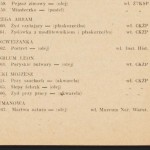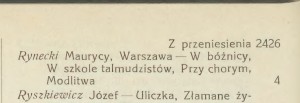The location of Rynecki paintings can be described in three categories: Museum Holdings, Archival Collections, and Private Holdings.
Details about exhibitions know to have included Moshe Rynecki’s paintings can be found below.
Museum Holdings
Żydowski Instytut Historyczny (ZIH or Jewish Historical Institute) has 52 Moshe Rynecki paintings in its collection. You can view some of them on the Central Jewish Library website:
Muzeum Narodowe w Warszawie (National Museum in Warsaw) has two of Moshe Rynecki paintings:
W Parku (In a Park), 1935
33.7 x 49.3 cm. Held by Muzeum Narodowe w Warszawie (National Museum in Warsaw)
Inventory number: Rys.W.2146
Photograph by Liegier Piotr/Muzeum Narodowe w Warszawie.
Talmudysci (The Talmudists), undated
31.5 x 47.8 cm. Held by Muzeum Narodowe w Warszawie (National Museum in Warsaw)
Inventory number: Rys.W.2145
Photograph by Liegier Piotr/Muzeum Narodowe w Warszawie.
The Magnes Collection of Jewish Art and Life in Berkeley, California has in its permanent collection this work depicting a wedding scene.
The Wedding (The Gift of Bread), 1919
Framed, 86.75 x 31.75 cm., oil on parchment, gift of George Rynecki
Yad Vashem, The Holocaust Martyrs’ and Heroes Remembrance Authority in Israel, has in its permanent collection this piece depicting refugees inside the Warsaw Ghetto.
Refugees, 1939
42 x 57 cm., watercolor sketch, gift of the Rynecki family
Archival Collections
In October 2013 I learned that the University of Toronto’s Thomas Fisher Rare Book Library had in its collection the papers of Otto Schneid. In this collection are original letters written by Moshe Rynecki to Schneid as well as several black and white photographs of Moshe’s paintings whose whereabouts as of this writing are unknown. The photos here are Courtesy of the Thomas Fisher Rare Book Library, University of Toronto.
Private Holdings
Canada
In October 2013 I visited a private collector in Canada to see these four Rynecki paintings and to film an interview for the Chasing Portraits documentary film. Details in this blog post.
Poland
These six pieces are held by a private collector in Poland.
Israel
A woman in Israel is believed to have these pieces.
United States
A Rynecki relative has this painting and wood carving. [Photos courtesy Chuck Fishman]
Two paintings sold at Sotheby’s in 1993 by a private collector are believed to be in the United States.
The Rynecki family is the largest known private collector of Moshe Rynecki’s paintings. Much of the collection can be viewed at this online gallery.
- Curious Children, 1928
France
Extended Rynecki family in France has this piece
Known Exhibitions
January 10 – April 30, 2020
The Jewish Heritage Museum at the Reutlinger Community (Danville): Moshe Rynecki: In Their Own Voices January 10 – April 30, 2020
“Inspired by Elizabeth Rynecki’s book and film, Chasing Portraits: A Greatgranddaughter’s Quest for Her Lost Art Legacy, we share the voice of the artist and two generations of the Rynecki family in exploration of Moshe Rynecki’s documentation of pre-war Warsaw Jewish life. Through the 1981 catalogue of the Magnes Museum’s exhibition, Moshe Rynecki: 1881-1943, curator Ruth Eis selections organize and words narrate the exhibition. The 2000 donation of the Ruth and Max Eis Collection of Judaica created the Jewish Heritage Museum. Display of its objects will complement the Rynecki images. Paintings by Ruth Eis will also be on display, thanks to donations by the Rude and Rynecki families. The Jewish Heritage Museum would like to thank the Rynecki family for the reproduction of the artwork, the catalogue loan and other ephemera. We are grateful to the University of California Bancroft Library and The Magnes Collection of Jewish Art and Life for permission to reproduce the catalogue and their donated Rynecki painting.”
26 January to 3 April 2016
Deutsches Historisches Museum. Berlin, Germany
ART FROM THE HOLOCAUST: 100 WORKS FROM THE YAD VASHEM COLLECTION
“In collaboration with the Foundation for Art and Culture, the German Historical Museum is exhibiting 100 art works from Yad Vashem, the World Holocaust Remembrance Center in Jerusalem, for the first time in Germany. The exhibition represents the culmination of events marking 50 years since the establishment of German-Israeli diplomatic relations. This is “hitherto the largest presentation of artworks from the Yad Vashem collection outside Israel, and should be cherished as an invaluable symbol of friendship. Located in Jerusalem, Yad Vashem is Israel’s official Holocaust memorial centre, whose museum is dedicated to presenting the history of the Shoah and its academic documentation.” – From the Deutsches Historisches Museum exhibition website page
The exhibit includes one Moshe Rynecki painting, Refugees (1939), shown here.
NBC Nightly news ran a story this evening about the exhibition. The story focuses on the work of Nelly Toll and while it does show close ups of some of the art, my great-grandfather’s painting can only be seen ever-so-briefly at the 1:15 mark. Watch the whole video here. Below, left, is a screen shot with a superimposed blue arrow pointing out the Rynecki painting.
New York Times: Art From the Holocaust’: The Beauty and Brutality in Forbidden Works
October 2014 – March 2015
Jewish Historical Institute. Warsaw, Poland
Salvaged
When the exhibit opened in October a single Rynecki painting was included. In May 2015 this one painting was removed and three others were presented. You can read the museum’s comments about the exhibition and about Elizabeth’s visit to the exhibition in October.
October, 2010
Muzeum Mazowsza Zachodniego w Żyrardowie
This history museum in Poland had an exhibit that included works by Moshe. The Rynecki family never was given photos of the works, but was told, “…there is a one room, that generally shows a craft. This part of exhibition including pieces by Mojsze Rynecki, which present a tailors, shoemakers, the family making a toys and some others.” This image comes from their catalog:
The text below reads: Mojzesz Rynecki, Krawiec, 1929, rysunek tuszem lawowany, 35,5 x 50, Zydowski Instytut Historyczny
In other words, painting by Moshe Rynecki, Krawiec (Tailor), 1929, ink drawing, 35.5 x 50 cm, held by the Jewish Historical Institute in Warsaw
2008
Museum Nadwislanskie in Kazimierz Dolny.
In Kazimierz the Vistula River spoke to them in Yiddish… Jewish painters in the art colony of Kazimierz. Researched by Waldemar Odorowski. The exhibition catalog includes six Moshe Rynecki pieces (pages 201-203)
April 15–May 7, 2003
Works by Jewish artists in Warsaw
[Note: This announcement was included in “Polonia de hoy,” a publication edited by the Polish Embassy in Havana. It appeared in issue #24 March/April 2003. The information was provided to the Embassy by the Ministry in Warsaw and the Polish Press Agency. Mr. Daniel Gromann, Charge d’affaires a.i. of the Republic of Poland in the Republic of Cuba, kindly provided the translation.] “Paintings, drawings and graphics by Polish artists of Jewish origin can be seen, starting from April 15 (until May 7), at an exhibition entitled ‘Our older brethren’ in the Gallery of the Jewish Historical Insititute in Warsaw. All the works presented come from the collection of the Institute. ‘We want to show the public the world which no longer exists. But what interests us is not the Holocaust, but the life of the Jews in our country before 1939,’ said Renata Piatkowska, a representative of the Jewish Historical Institute. In the paintings and drawings their authors depicted scenes relating to the daily life and customs of the Jewish community in Poland. The exhibition contains works by authors from the second half of the 19th century and from the 20th century, such as Mojzesz Maurycy Rynecki [our emphasis], Otto Axes and Wilhelm Wachtel. An important element of the exhibition is a part of the so-called Gallery of the Rabbis, which includes 18 of the 90 portraits of Jews made with a fountain pen. The drawings show important and well-known figures of the Jewish community: Rabbis, intellectuals and social activists. At the beginning of this year, the exhibition was shown in Poznan, in the context of the Seventh Session of Dialogue between Christians and Jews.”
1989
National Museum in Krakow, Poland.
Exhibit under the protection of the Ministry of Culture and Art. Page 81 of the catalog lists 22 paintings included in the exhibit.
November 8, 1981–January 17, 1982
Judah L. Magnes Museum, Berkeley, California
Magnes Museum Women’s Guild Fall Show. A centennial showing of Moshe Rynecki’s art. The exhibit was curated by Ruth Eis.
June, 1951
Jewish Community Center, Dallas, Texas
46 canvases were displayed.
1948
Wystawa dzieł żydowskich artystów plastyków męczenników niemieckiej okupacji 1939–1945 [Exhibition of Works of Jewish Artists Martyrs of the German occupation 1939-1945]
The titles of the 3 Rynecki paintings included in the exhibit:
Przy szachach – A game of chess
Slepy zebrak – Blind Beggar
Żyd przy pracy – Jew at work
Read more about the 1948 exhibition in my blog post.
1939
Fifth Jubilee Salon of Paintings and Sculpture, Organization of Jewish Artists and Sculptors
1937
Bazaar of Pictures[Article in Unzer Ekspres: Bazaar of Pictures]
1936
Jewish Art Salon, The Jewish Society for the Advancement of Art
[Article in Haynt: Exciting Opening of the Jewish Art Salon in Warsaw]
Title of exhibited piece:
Modlitwa z Rodalami [Prayer with the (Torah) scrolls]
The piece is also listed in Przewodnik / Towarzystwo Zachęty Sztuk Pięknych w Warszawie: Salon 1936. 1936 nr 118 (grudzień) [Guidebook/ Zachęta Society in Warsaw, Salon 1936, No 118, December 1936] p. 31:
1932
Zacheta
Titles of exhibited pieces with English translations
Talmudysci [Talmudists]
W boznicy [In the synagogue]
Odczytywanie rodały [Reading the Torah scrolls (but please note I’ve been told there is a slight nuance here that might be difficult to translate, especially since we don’t know the content of the painting itself. “Odczytywanie rodałów,” the title used, is different from “Czytanie rodałów”. The latter means reading Torah one one’s own. The title seems to instead refer to some sort of public reading (presumable in synagogue) of the Torah for the benefit of others.)]
Rozwod [Divorce]
Modlitwa z palmami [Prayer with palm branches (?). (Please note that on palm branches and Judaism, Wikipedia says this: “In Judaism, the date palm (Lulav) is one of the Four Species used in the daily prayers on the feast of Sukkot. It is bound together with the hadass (myrtle), and aravah (willow). The Midrash[15] notes that the binding of the Four Species symbolizes the desire to unite the four “types” of Jews in service of God.”)]
W szkole [At School]
Przewodnik. Nr. 74
Talmudyści (akwarela)
W bóżnicy (akwarela)
1931
Zacheta
Titles of exhibited pieces with English translations
Dybuk [The Dybbuk]
Swieto swieczek [Feast of Candles (Perhaps a reference to Hanukkah?)]
Rabin Naucza [Rabi is Teaching]
Głowka [Little head (perhaps the portrait of a child?)]
Na Wywczasach [pre-war spelling of Na wczasach, meaning, on holiday or on vacation]
Umierajaca [Dying woman]*
Kataryniarz [Organ-grinder]*
* Both Dying Woman and Organ-grinder are also listed in Przewodnik / Towarzystwo Zachęty Sztuk Pięknych w Warszawie. 1931 nr 69 (grudzień) [Guidebook/ Zachęta Society in Warsaw, No 69, December 1931] p. 35
Przewodnik. Nr. 67
G łówka (akwarela)
Na wywczasach (olej)
1930
Jewish Society for the Promotion of Fine Arts (Żydowskie Towarzystwo Krzewienia Sztuk Pięknych- ŻTKSP)
The 44th Annual Show, 26 Dluga Street, Warsaw, Poland
Titles of exhibited pieces with English translations
Przyjęcie Nowożeńców [Reception of the Newlyweds]
Wesele [Wedding]
Katarynka [Barrel organ – as used by an organ grinder]
W szkole talmudystow I [Talmudic School I]
Talmudysci [Talmudists]
W szkole talmudystow II [Talmudic School II]
Święto Tory [Celebration of the Torah (Simchat Torah (?)]
W boznicy [In the synagogue]
Przewodnik. Nr. 57
Talmudyści — ol.
Przewodnik. Nr. 55
Święto Tory — ol.
W bóżnicy — ol.
Za chlebem — ol.
Przewodnik. Nr. 53
W szkole talm udystów — ol.
Przewodnik Nr. 52
K atarynka — ol.
W szkole talm udystów — ol.
Talm udyści — ol.
Przewodnik Nr. 51
Wesele — ol.
Przewodnik Nr. 50
Przyjęcie nowożeńców — ol.
1929
Society for the Advancement of Fine Arts, Warsaw
Titles of exhibited pieces with English translations
W boznicy [In the synagogue]*
W szkole talmudzistow [Talmudic school]*
Przy chorym [When sick]
Modlitwa [Prayer]
Two articles in Unzer Ekspres: Opening of Exhibition and Great Success of Exhibit]
[NOTE: * also included in Przewodnik 1929 Number 46]
May 1929
Salon Wiosenny XL [ Spring Salon 40 ] of Żydowskie Towarzystwo Krzewienia Sztuk Pięknych [ The Jewish Association for the Promotion of Fine Arts] lists two paintings by B. Rynecki (presumably a typographical error that should read M. Rynecki):
“Szma Israel”
Talmudyści
1928
Spring Salon of Jewish Art
Gallery at 6 Rymarska Street, Warsaw
